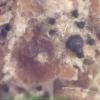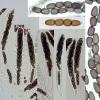
30-11-2025 12:53
 Edvin Johannesen
Edvin Johannesen
White short-stipitate apothecia found on thin twig

30-11-2025 10:47
 William Slosse
William Slosse
I recently found a collection of small Peziza sp.

27-11-2025 12:01
Thomas Læssøehttps://svampe.databasen.org/observations/10496727

27-11-2025 11:46
Thomas Læssøehttps://svampe.databasen.org/observations/10493918

17-09-2025 10:50
Heather MerryleesHi there!I am hoping for any advice on the identif

29-11-2025 08:40
 Andreas Millinger
Andreas Millinger
Hello,on a splintered part of a branch on the grou

28-11-2025 16:45
Nogueira HéctorNovember 23, 2025 Requejo de Sanabria (León) SPAI

25-11-2025 14:24
Thomas Læssøehttps://svampe.databasen.org/observations/10490522

27-11-2025 15:41
Thomas LæssøeSpores brownish, typically 4-celled; 26.8 x 2.4;

27-11-2025 11:31
Thomas LæssøeCollectors notes: Immersed ascomata, erumpent thro
The spores are (26.7) 27.8 - 34.9 (36.9) × (4.8) 5.0 - 6.3 (6.8) µm, soon breaking up into four part spores. The asci are (108.7) 120.4 - 151.5 (184.7) × (10.1) 11.6 - 14.2 (14.6) µm. Other details in the photos.
Ideas, anybody?
------
Update: I was wrong about the substrate - it is black grouse (Tetrao/Lyrurus tetrix).
Why not minima?

Look towards S.minimoides, the germinal clefts correspond better. The spores and measurements of these two species are quite variable.
Michel.
The pseudothecia are about double size when compared to descriptions of minimoides. I measured the the part of the ascus base to the lowest spore and got these results (11.5) 13.8 - 58 (101.9) µm, Me = 33.9 µm while Ahmed & Cain say 4-6 µm. The spore width is a better match with minima than with minimoides.
I also compared to these and other photos:
https://www.pilzforum.eu/board/thread/46967-sporormiellas-aus-namibia/
Minimoides is said to be a thermophilic species. This specimen was collected on grey dunes on a south facing slope exposed to sun all day, so the thermophily criterion is fulfilled. The species is on the Finnish checklist but I know no details about that.
I feel that the differences are too big for this to be minimoides. But then my experience of this genus is limited

Pilzforum.eu is my favourite site what comes to coprophilous species. Unfortunately I don't write German even though I can read it. Thank you, Norbert!

Taking all the information and the latest details, I wonder if S.leporina would not be more suitable for the length of the spores as well as their shape.
Michel.



I did not observe that that there are spores of two different sizes.
In Helotiales there is a length difference between living and dead spores of 6-18 percent. Or ascus width 17-26 percent reduction. I suppose the situation could be the same also for perithecial/psedothecial fungi. Perhaps when measuring living material reduce by x percent before compairing to Ahmed & Cain?
Stefan

